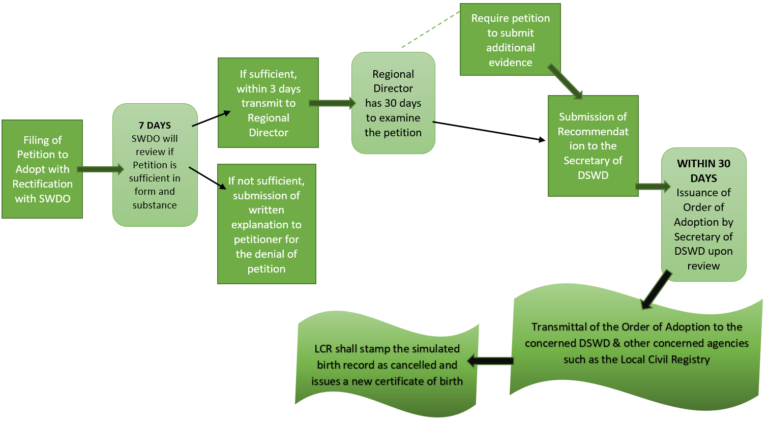
Published — March 19, 2019
The following post does not create a lawyer-client relationship between Alburo Alburo and Associates Law Offices (or any of its lawyers) and the reader. It is still best for you to engage the services of your own lawyer to address your legal concerns, if any.
Also, the matters contained in the following were written in accordance with the law, rules, and jurisprudence prevailing at the time of writing and posting, and do not include any future developments on the subject matter under discussion.
Related Article: Frequently Asked Questions on Adoption in the Philippines
On February 21, 2019, Republic Act No. 11222 (RA 11222), otherwise known as the Simulated Birth Act was signed into law by the President. The newly signed law provides for the rectification of simulated birth records, amnesty or exemption from criminal, civil, and administrative liability of those who simulated the birth record of a child, and a simplified administrative adoption proceeding. All of these are subject to an indispensable requisite that the simulation of the birth record was carried out consistently for the best interest of the child.
Best interest of the Child
Under the Universal Declaration of the Rights of the Child, the child, by reason of his mental and physical immaturity, needs special safeguard and care, including appropriate legal protection before as well as after birth. This was anchored to the principle of “best interest of the child” which pervades Philippine cases involving adoption, guardianship, support, personal status, minors in conflict with the law, and child custody. In these cases, it has long been recognized that in choosing the parent to whom custody is given, the welfare of the minors should always be the paramount consideration. As such, courts are mandated to take into account all relevant circumstances that would have a bearing on the children’s well-being and development. Aside from the material resources and the moral and social situations of each parent, other factors may also be considered to ascertain which one has the capability to attend to the physical, educational, social and moral welfare of the children. Among these factors are the previous care and devotion shown by each of the parents, their religious background, moral uprightness, home environment and time availability, as well as the children’s emotional and educational needs (Pablo-Gualberto vs. Gualberto, 461 SCRA 450, June 28, 2005).
Removing of Child’s True and Biological Mother from Records
The Simulation Birth Act covers circumstances where any person or persons tampered or falsified documents from civil registry to make it appear in the record of birth, that a child was born to a person who is not the child’s biological mother, causing the loss of the true identity and status of such child. (Art.1 Sec. 3 (f) and Art. 2 Sec. 4 of RA No. 11222). It must also be emphasized that the law clearly points out that the material fact omitted, tampered and/or falsified on the child’s birth record must be the child’s biological mother.
Amnesty
The simulation of birth of a child can result to two (2) different crimes, these are, Simulation of Births under Article 347 of the Revised Penal Code (RPC) and Falsification of Public Documents under Articles 171 and 172 of RPC.
Under Article 347 of the Revised Penal Code, simulation of birth is punishable by prision mayor (six (6) years and one (1) day to twelve (12) years imprisonment) and a fine not exceeding one thousand pesos (PhP 1,000.00). Simulation of birth takes place when a woman commits an act to make it appear that she gave birth to a child when in truth and in fact she is not the biological mother of the child (Simulation of birth can void foundling’s claim to mom’s assets by Persida Acosta).
On the other hand, in the case of Anonymous vs. Curamen 621 SCRA 212, June 18, 2010, in case of falsification of the child’s birth certificate, such person committed the crime of Falsification of Public Document. A birth certificate, being a public document, serves as prima facie evidence of filiation. The making of a false statement therein constitutes dishonesty and falsification of a public document.
Due to the enactment of RA 11222, person or persons involved in the simulation of birth of the child may escape liabilities from the abovementioned crimes provided that the act was done consistently for the best interest of the child.
Administrative Adoption and Rectification
The simplified process of adoption offered by RA 11222 is available only when what is filed by the petitioner is a Petition for Adoption with an application for the Rectification of the simulated birth record. To get the better picture of what is truly offered by the said law, the following are the requirements for the availment of Administrative Adoption and Rectification:
- There was simulation through tampering of birth records of the child;
- The simulation of the birth record was consistently made for the best interest of the child;
- The subject child was treated by the petitioner as his or her own;
- That the adopters possess the additional personal requirements.
In view thereof, the additional personal requirements of the adopters are:
- Being of Filipino citizenship;
- Legal age;
- Possess full civil capacity and legal rights;
- Having of good moral character;
- Have not been convicted of any crime involving moral turpitude;
- Emotionally and psychologically capable of caring for children; and
- In a position to support and care for the child in keeping with the means of the family.
In case of adoption by a married couple, where one of the adopters is a foreign national married to a Filipino, the foreign national must have been residing in the Philippines for at least three (3) continuous years prior to the filing of the petition for adoption and application for rectification birth record. (Art. 3, Sec. 7 of RA 11222)
A written consent is also required from the following persons, in these cases:
- The adoptee is ten (10) years of age or over;
- When the legitimate and adopted daughters and sons, ten (10) years of age or over, of the adopter and adoptee;
- When the illegitimate daughters and sons, ten (10) years of age or over, of the adopter if living with said adopter; and
- The latter’s spouse, and the spouse of the adoptee. (Art. 3, Sec. 8 of RA 11222)
Procedure
The petition for adoption with an application for rectification of simulated birth record shall be in the form of a subscribed and sworn affidavit by the petitioner or petitioners. It shall state the facts necessary to establish the merits of the petition, and the circumstances surrounding the simulation of the birth of the child. The petition shall be supported by the following documents:
- Copy of simulated birth or foundling certificate of the child;
- Affidavit of admission if the simulation of birth was done by a third (3rd) person;
- Certification issued and signed by the punong barangay attesting that the petitioner/s is or are resident/s of the barangay, and that the child has been living with the petitioner/s for at least three (3) years prior to the effectivity of this Act;
- Affidavits of at least two (2) disinterested persons, who reside in the same barangay where the child resides, attesting that the child has been living with the petitioner for at least three (3) years prior to the effectivity of this Act;
- Certification declaring a child legally available for adoption (CDCLAA) issued by the DSWD. However, this shall no longer be required if the adoptee is already an adult or a relative of the adopter within the fourth (4th) degree of consanguinity or affinity;
- Photographs of the child and the petitioner/s taken within the last three (3) months prior to the filing of the petition. (Art. 4, Sec. 9 of RA 11222)
The process of adoption starts with the filing of the Petition for Adoption with application for rectification and the supporting documents to the Office of the Social Welfare and Development Officer (SWDO) of the city or municipality where the child resides. The SWDO will examine the Petition within seven (7) days. If the petition is insufficient in form or substance, the SWDO will return the petition to petitioner with written explanation for its denial. On the other hand, if SWDO finds the petition sufficient in form and substance, SWDO will forward the petition to the Regional Director within (3) days. The Regional Director shall review the petition and prepare a recommendation not later than thirty (30) days from receipt thereof. During the deliberation, the Regional Director may direct the petitioner/s to submit additional documents to support their petition. After 30 days, the Regional Director will transmit the Petition to the Secretary of DSWD. The Secretary shall act and decide on the petition within 30 days from receipt of the recommendation from the Regional Director (Art. 4, Sec. 10 of RA 11222). If the Secretary determines that the adoption redounds to the best interest of the child, the Secretary will issue an Order of Adoption. Consequently, the Secretary shall transmit the order of adoption to the concerned agencies, especially to the Local Civil Registrar (LCR). The LCR shall stamp the old record cancelled and issues a new one. (Art. 4, Sec 12 of RA 11222). A summary of the procedure is described as follows:
Order of Adoption
Once the Secretary of DSWD determines that the best interest of the child will be fervently served, an Order of Adoption will be issued. Such order contains the name by which the adoptee shall be known and it directs that:
- Cancellation of the simulated birth record of the child;
- Issuance of the rectified birth record bearing the names of the biological parents of the child or the issuance of a foundling certificate; and
- Issuance of a new birth certificate. (Art. 4, Sec 11 of RA 11222).
Upon the finalization and conclusion of the procedure, adoptee will be considered the legitimate child of the adopter and is entitled to all the rights and obligations provided by law to legitimate children.
Alburo Alburo and Associates Law Offices specializes in business law and labor law consulting. For inquiries, you may reach us at info@alburolaw.com, or dial us at (02)7745-4391/0917-5772207.
All rights reserved.
SUBSCRIBE NOW FOR MORE LEGAL UPDATES!
[email-subscribers-form id=”4″]



Will RA 11222 also cover rectification in the simulated birth certificate without adoption? Like, a young single mother who left the child to the father. The father’s mother took the child with her. The child was hidden from the mother, the father telling that the child was brought to Visaya, by his mother. The father too could not be seen for some time. A very poor young mother cannot just follow her child, and where? It was found out later that the child was just around. For school requirement, the child was late registered with a birth certificate bearing the name of the father’s new live-in partner as the mother. Advices from the biological mother’s in-laws encouraged her to claim the child.(to be continued if needed).